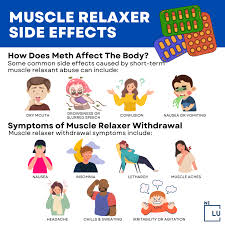Muscle relaxers and pain blockers are vital in managing a range of conditions related to muscle spasms, tension, and chronic pain. These medications work by influencing the communication between the brain, spinal cord, and muscles, leading to the reduction of pain, muscle tightness, and inflammation. Understanding the mechanisms behind these medications helps demystify their effectiveness and sheds light on the intricate relationship between nerve impulses and pain relief.
The Basics of Muscle Relaxers and Pain Blockers
Muscle Relaxers are primarily used to relieve muscle spasms, which are involuntary muscle contractions often caused by injury, overuse, or conditions like fibromyalgia. These drugs work by affecting the central nervous system (CNS) or the neuromuscular junction to reduce muscle tone and improve mobility. Common muscle relaxers include medications like Carisoprodol (Pain O Soma), Cyclobenzaprine, and Baclofen.
Pain Blockers (also called analgesics) work by blocking pain signals from reaching the brain or altering how the brain processes these signals. Analgesic medications range from over-the-counter drugs like acetaminophen to more potent opioid medications like morphine. Nonsteroidal anti-inflammatory drugs (NSAIDs) such as ibuprofen also fall under this category by inhibiting the inflammatory response that causes pain.
Although muscle relaxers and pain blockers serve different functions, they often overlap in their mechanism of action, especially when it comes to treating conditions like back pain, sciatica, or tension headaches. They can either target the peripheral nervous system (PNS) or central nervous system (CNS), influencing the body’s ability to perceive and react to pain.
The Role of the Nervous System in Pain and Muscle Function
To understand how muscle relaxers and pain blockers work, we must first explore the role of the nervous system in pain and muscle function. The nervous system consists of two major components: the CNS and the PNS.
- The Central Nervous System (CNS): The CNS includes the brain and spinal cord, where sensory signals, including pain, are processed. Pain signals are transmitted from the affected area to the brain via sensory nerves. Once the brain receives these signals, it interprets them as pain, and the body responds by generating reactions like muscle tension or withdrawal from the painful stimulus.
- The Peripheral Nervous System (PNS): The PNS is a network of nerves outside the brain and spinal cord that transmits information from the body to the CNS and vice versa. Pain receptors, or nociceptors, located throughout the body, are activated by harmful stimuli, such as injury or inflammation, and send pain signals to the CNS for processing.
Pain perception is a complex interaction between the PNS and CNS. When the body experiences pain, sensory nerves (A-delta and C fibers) transmit electrical signals to the spinal cord, which then relays these signals to the brain. The brain processes these signals and interprets them as pain, which leads to various responses, including muscle tension, increased heart rate, and changes in behavior.
How Muscle Relaxers Work: Influencing Nerve and Muscle Communication
Muscle relaxers target the mechanisms of muscle contraction and the communication between nerves and muscles. The process of muscle contraction starts with a nerve impulse originating from the brain, which travels down the spinal cord and reaches the muscle fibers via motor neurons. Upon reaching the muscle, the nerve releases acetylcholine, a neurotransmitter that binds to receptors on the muscle, causing it to contract.
In the case of muscle spasms, this process becomes disrupted. Muscle fibers remain contracted for extended periods, leading to pain, stiffness, and decreased mobility. Muscle relaxers work by altering the transmission of nerve signals or by directly affecting the muscle fibers to promote relaxation.
- Central-Acting Muscle Relaxers: These medications affect the CNS by targeting the spinal cord or brain to reduce muscle tone and inhibit the reflex arcs responsible for muscle spasms. Drugs like Carisoprodol (Pain O Soma) and Cyclobenzaprine interfere with neurotransmitters in the CNS, blocking the transmission of pain signals to the brain and inhibiting the muscle’s ability to contract involuntarily. This helps relax the muscles and alleviate pain associated with muscle spasms.
- Carisoprodol works by depressing the CNS, which reduces the excitability of the neurons involved in muscle contractions. By dampening the activity in the brain and spinal cord, it lessens the spasticity and tightness of muscles.
- Cyclobenzaprine is another central-acting muscle relaxant, primarily working by inhibiting the brainstem’s motor pathways. It reduces the nerve signals that cause involuntary muscle spasms, allowing the muscles to relax.
- Direct-Acting Muscle Relaxers: Other muscle relaxers, such as Baclofen, act directly on the muscle fibers or the neuromuscular junction to reduce muscle contraction. Baclofen mimics the effects of a neurotransmitter called GABA (gamma-aminobutyric acid), which is naturally inhibitory in the nervous system. By activating GABA receptors, Baclofen reduces muscle tone and spasm by inhibiting the transmission of excitatory signals between the motor neurons and the muscle.
Pain Blockers and Their Mechanisms: How They Block Pain Signals
Pain blockers, on the other hand, are designed to interfere with the communication between the PNS, CNS, and the perception of pain. While muscle relaxers are more focused on the muscles themselves, pain blockers work to stop or reduce pain signals before they can reach the brain or alter how the brain interprets these signals.
- NSAIDs (Nonsteroidal Anti-Inflammatory Drugs): Medications like Ibuprofen and Aspirin are common pain blockers that work by inhibiting the enzyme COX (Cyclooxygenase). COX is responsible for producing prostaglandins, which are chemicals in the body that promote inflammation and pain. By blocking COX, NSAIDs reduce the production of prostaglandins, leading to decreased inflammation and pain relief.
- Acetaminophen: Unlike NSAIDs, Acetaminophen (Tylenol) works mainly in the brain. It inhibits the production of prostaglandins in the brain, reducing pain perception. However, it does not have the anti-inflammatory properties of NSAIDs, making it effective for mild to moderate pain but not inflammation-based pain.
- Opioid Analgesics: For severe pain, Opioid medications like Morphine and Oxycodone bind to opioid receptors in the brain and spinal cord. These receptors, when activated, inhibit the release of neurotransmitters involved in pain transmission. By blocking these pain signals, opioids significantly reduce the perception of pain, though they carry a higher risk of dependence and side effects.
- Gabapentinoids (Gabapentin and Pregabalin): Gabapentin and Pregabalin are often used in neuropathic pain management. These drugs target calcium channels in nerve cells to reduce the release of neurotransmitters involved in pain transmission. They are especially effective for conditions like diabetic neuropathy, shingles, and fibromyalgia.
The Synergy of Muscle Relaxers and Pain Blockers in Treatment
When used together, muscle relaxers and pain blockers provide a synergistic approach to pain relief. Muscle relaxers reduce the underlying muscle spasms and tension that often contribute to pain, while pain blockers inhibit the pain signals themselves. This combined approach addresses both the mechanical (muscular) and neurological components of pain, offering more comprehensive relief.
For instance, someone with chronic back pain may take a muscle relaxer like Carisoprodol to alleviate the spasms in the muscles that have been tensed up from prolonged pain. At the same time, they might use an NSAID like Ibuprofen to reduce the inflammation in the affected area and block the pain signals traveling to the brain.
In cases of neuropathic pain, a patient might be prescribed Gabapentin or Pregabalin alongside a muscle relaxer to address the nerve pain and muscle tightness, respectively. This dual approach can help patients manage both the physical discomfort and the underlying cause of pain, leading to improved mobility and quality of life.
Conclusion: The Complexity of Pain and Muscle Spasms
Muscle relaxers and pain blockers are indispensable tools in modern pain management, acting on different pathways of pain perception and muscle function. By influencing the communication between the brain, spinal cord, and muscles, these medications provide relief from conditions ranging from muscle spasms to chronic pain syndromes.
Whether targeting the central nervous system or the neuromuscular junction, these drugs work to modulate the way pain is perceived and how muscles respond to stress and injury. In combination, they offer a powerful way to manage complex pain conditions, improving the quality of life for patients and enabling them to return to normal activities more quickly.
While these medications can be highly effective, they should always be used with caution, under the supervision of a healthcare provider, due to potential side effects, interactions, and the risk of dependency, especially with stronger pain blockers. Understanding how these medications work at the molecular level helps not only in their proper use but also in creating more personalized treatment plans for patients experiencing pain and muscle dysfunction.
Also Read
- ► The Mystery of Black Bitumen Paint: What Makes It Indispensable?
- ► Can Phone Tracker Rescue Kids from Dangerous Situations
- ► Why Online Gaming Fans Love Fantasy and Casino Titles Equally
- ► Unveiling the Grace of Pakistani Sarees: A Blend of Tradition and Modern Elegance
- ► Everything You Need to Know About a 50 Gallon Electric Water Heater
- ► Revolutionizing the Skies: How Future Aircraft Development Will Transform the World
- ► Expert’s Guide to Circuit Breakers: Benefits, Types, and Top 3 Choices!
- ► Discover the Cool Cars at the Proton Showroom in 2025
- ► Pakistani Sarees: Exploring the Elegance of Tradition and Style
- ► How Cloud Services Will Support the Growth of Smart Manufacturing by 2025?
- ► Why Choose Expert Post-Handover Inspectors?
- ► Ace PTE Academic Select Missing Word Task with Easy Tips
- ► Print Guru: Trusted in Custom & Small Booklet Printing for 30+ Years
- ► The Right Countertops for Small Kitchens
- ► Affordable Best Solar Cables prices in Pakistan





